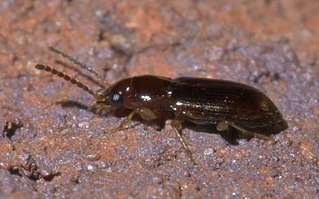
Cicindela, commonly known as common tiger beetles, are generally brightly colored and metallic beetles, often with some sort of patterning of ivory or cream-colored markings. They are most abundant and diverse in habitats very often near bodies of water with sandy or occasionally clay soils; they can be found along rivers, sea and lake shores, sand dunes, around dry lakebeds, on clay banks, or woodland paths.

Xyletinus is a genus of death-watch and spider beetles in the family Ptinidae and subfamily Xyletininae.

Eleodes is a genus of darkling beetles, in the family Tenebrionidae. They are endemic to western North America ranging from southern Canada to central Mexico with many species found along the Mexico-United States border. Some species have been introduced to Colombia. The name pinacate is Mexican Spanish, derived from the Nahuatl (Aztec) name for the insect, pinacatl, which translates as "black beetle".

Agonum is a large genus of ground beetles in the subfamily Harpalinae, tribe Platynini. They are mid-sized to smallish beetles, typically with dark metallic hues – often reddish or bronze, but sometimes black, green etc.

Altica is a large genus of flea beetles in the subfamily Galerucinae, with about 300 species, distributed nearly worldwide. The genus is best represented in the Neotropical realm, well represented in the Nearctic and Palearctic, but occurs also in the Afrotropic, Indomalaya, and Australasia. The species are similar to each other, small metallic blue-green-bronze beetles, often distinguished from each other only by the aedeagus. The species of Altica, both as larvae and as adults, are phytophagous, feeding on plant foliage of various food plant taxa, specific for each Altica species. Onagraceae and Rosaceae are the dominant host plant families for Holarctic species. The adult Altica beetles are able to jump away when approached.

Dorcatominae is a subfamily of death-watch and spider beetles in the family Ptinidae. There are about 16 genera and at least 190 described species in Dorcatominae.
Megorama is a genus of death-watch and spider beetles in the family Ptinidae. There are about five described species in Megorama.
Byrrhodes is a genus of death-watch and spider beetles in the family Ptinidae. There are about 14 described species in Byrrhodes.

Bradycellus is a genus in the beetle family Carabidae. There are more than 120 described species in Bradycellus.

Xylotrechus a genus of longhorned beetles of the family Cerambycidae, containing some 200 described species.

Typocerus is a genus of beetles in the family Cerambycidae, containing the following species:

Neoclytus is a genus of beetles in the family Cerambycidae. They measure 4-20 mm. There are 93 species in the New World.

Epicauta is a genus of beetles in the blister beetle family, Meloidae. The genus was first scientifically described in 1834 by Pierre François Marie Auguste Dejean. Epicauta is distributed nearly worldwide, with species native to all continents except Australia and Antarctica. Surveys have found the genus to be particularly diverse in northern Arizona in the United States. Few species occur in the Arctic, with none farther north than the southern edge of the Northwest Territories, Canada.

Lytta is a genus of blister beetles in the family Meloidae. There are about 70 described species in North America, and over 100 species worldwide.

Hemicrepidius is a genus of click beetle belonging to the family Elateridae.

Enochrus, a genus of water scavenger beetles, is the third-largest genus of hydrophilids with 229 species in six subgenera worldwide.

Magdalis is a genus of wedge-shaped bark weevils in the family Curculionidae. There are at least 20 described species in Magdalis.

Ophryastes is a genus of broad-nosed weevils in the family Curculionidae. There are at least 30 described species in Ophryastes.

Phyllobaenus is a genus of checkered beetles in the family Cleridae. There are at least 60 described species in Phyllobaenus.

















